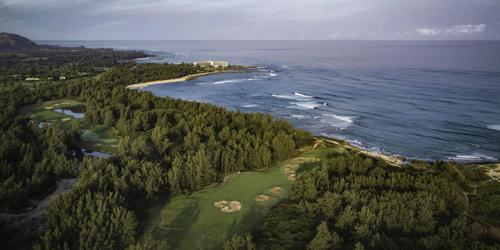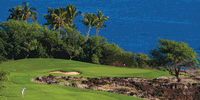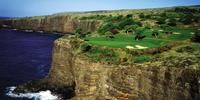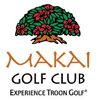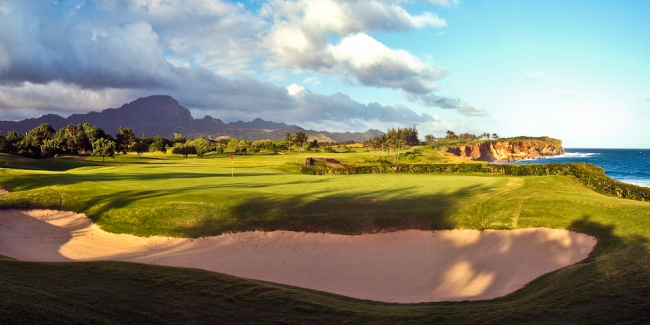
Kauai, Hawaii
Heavenly Golf in Paradise
By Mike Dauplaise
Splashing in the crystal-clear waters of Hanalei Bay, gazing upon the splendor of Waimea Canyon, hiking the Kalalau Trail or just kicking back at the beach, Kauai presents a veritable smorgasbord of sensory and physical stimulation for a Hawaiian vacation.
In fact, with all of the incredible sights and postcard-perfect beaches at your disposal on the Garden Isle, golf may not be the most obvious activity choice for a visit to Kauai. However, a succession of multi-million-dollar renovations at the island's four premier public courses has resurrected Kauai's status as a golf destination, making it worth the extra baggage fee to pack the clubs for your stay in paradise.
The Jack Nicklaus-designed Kauai Lagoons Golf Club on the east shore, and the Robert Trent Jones Jr. trio of the Makai and Prince courses on the north shore and Poipu Bay Golf Course on the south shore offer golfers a variety of top-notch experiences that add to the allure of a Kauai vacation.
Kauai Lagoons Golf Club
After several years out of commission, the lone Nicklaus course on the island reopened with a flourish in May 2011, featuring several new holes that maximize the property's dramatic ocean views.
Formerly a 36-hole club, Nicklaus and his team revamped the property to include an 18-hole championship course and a nine-hole, walking-optional loop called the Waikahe Nine that is billed as beginner-friendly because of its relative lack of forced carries. Kauai Lagoons sits on the Marriott property near Lihue, just minutes south of the airport.
The championship course includes the Moana Nine (meaning "toward the ocean") and Mauka Nine (meaning "toward the mountain"). As part of the renovation of the Moana Nine, the course gained a new hole that gives Kauai Lagoons the longest stretch of continuous ocean holes in Hawaii. New TifEagle greens and rebuilt bunkers with white silica sand provide enhancements in terms playability and visual appeal.
"We have over a half-mile stretch of ocean holes," says Scott Ashworth, PGA, Director of Golf at Kauai Lagoons. "It's quite a stretch of golf holes, giving us one of the strongest finishing nine holes in the state."
The Mauka Nine serves as the front side of the championship course, which measures 7,120 yards from the tips. Be aware that Kauai courses play all of their listed length due to the heavier sea-level air, trade winds and often-soft fairways from rains that give Kauai its garden nickname.
As with many Nicklaus designs, the par-3s are among the most enticing holes at Kauai Lagoons. The 219-yard fifth on the Mauka Nine plays over a mango forest to an elevated green, while the 210-yard fifth on the Moana Nine uses Nawiliwili Harbor as a backdrop for a heart-stopping shot over an ocean chasm. Nicklaus did not mess with perfection during the renovation process, leaving the hole unchanged in its picture-perfect original state.
Players familiar with the course will notice several completely new holes on the Moana Nine, highlighted by the 473-yard, par-4 sixth. Be wary of taking the option down the left side, because the fairway disappears into a jungle valley shortly over the crest of the hill. Something less than a driver is the smart choice if playing any of the forward tees, as the downhill angle and downwind trades will add distance to your tee shot.
If you need a birdie at the last to rescue a good round, you're likely out of luck. The ninth on the Moana Nine (which plays as the 18th on the championship course), is a 459-yard brute with a lagoon in play the entire length of the hole down the right side and in front of the green. A bunker just left of the peninsula green formerly served as a safe miss that kept balls out of the lagoon. However, it was removed in the renovation and balls now find their way into the water more often.
The Mauka Nine and the Waikahe (walking-optional) Nine also will have their turns in the renovation cycle. However, the club will have at least 18 holes open to ensure a complete round of quality golf.
For more information, see
The Prince Course
The north shore residential and resort community of Princeville is home to a pair of Robert Trent Jones Jr. courses, with the Prince generally acknowledged as the crown jewel of Kauai golf. The Prince is one of only two courses in Hawaii consistently listed on Golf Digest's "Top 100 Greatest Courses" in America.
The Prince reopened in March 2012 after an extensive 13-month renovation process that restored original design aspects, upgraded overall course condition and improved playability for all skill levels. The project included refurbishment of the spectacular 60,000-square-foot clubhouse, which includes the Tavern Restaurant by Roy Yamaguchi. The views from the clubhouse alone are worth the visit.
"Our firm implemented a wide-ranging refreshment of The Prince that returned the golf course to its original pristine condition," Jones says. "Perhaps our most dramatic refinement efforts focused on the complete reconstruction of every green complex, recapturing hole locations that had been lost over time."
The Prince weighs in at a beefed-up 7,378 yards from the black tees. Unless you're a scratch player with incredible length, I would suggest you check your ego at the bag drop and select a less-demanding set of tees. The golds (7,040), blues (6,567), whites (6,122) and reds (5,402) offer more than enough challenge to hold your attention.
In fact, one staff member told me he's played hundreds of rounds at The Prince, and can count on one hand the number of times he's managed to get around without losing a ball. Another told me the staff plays at the neighboring Makai Course to shoot a decent score, before returning to The Prince to have their egos pounded into submission yet again.
Is The Prince really that difficult? In a word, yes. The 76.2 course rating and 140 Slope rating from the tips doesn't do it justice. It's way harder than that. If the trade winds are blowing, forget about it.
That said, The Prince is a magnificent test of golf that will leave you wanting to play it again and again. The new SeaDwarf Seashore Paspalum turf and remodeled bunkers provide wonderful playing surfaces, and the views of beach, ocean, mountains, jungles and valleys are stunning.
"We gently reconfigured the contours in the green surfaces to accommodate the green speeds that can be achieved with the new grass," Jones explains. "In addition, we widened the fairway mowing patterns dramatically to promote a more enjoyable experience for players of all skill levels."
There is no such thing as easing into your round at The Prince. The first hole demands your full attention at 448 yards, downhill to an angled fairway, with death and destruction on both sides. The approach shot over a hazard to a rebuilt green complex makes par a great score.
The 207-yard seventh offers one of the most spectacular, grip-tightening par-3s on the island. With the trade winds typically blowing in your face, the tee shot is all carry over a 200-foot-deep ravine, with the only safe miss area to the right. Multiple tee sets provide varying angles of attack. Be sure to take a moment for some photos here, with beautiful Anini Beach down the bluff to your left.
The par-5s at The Prince are a thinking player's delight. Meandering ravines demand layups here and brute strength there, and greedy play typically results in disaster. Perhaps the most fun of the group is the 588-yard 10th. The hole boomerangs to the left around a ravine hazard, and depending on the wind, it's possible to get home in two with a hero second shot. The smart play is around the trouble to the right, but even that strategy is no guarantee of par.
Jones calls the 576-yard 15th "one of the best par-5s of my career." From an elevated tee, the fairway flows down the hill right-to-left to the precipice of a wide ravine. The second shot must carry the ravine and steer clear of a hazard down the right as the fairway approaches a green perched atop a rise. "Huge amounts of fairway have been introduced to the left of the green, allowing timid players a place to bail out, but leaving a precise chip shot with little room for error," he says.
Even the so-called easier holes present their share of diabolical terror. Just try hitting the fairway on the 390-yard 13th when the winds are howling into you from the left. Only the truly brave can start their tee shots far enough left over the jungle to allow the wind to bring it back to the fairway nestled 150 feet below.
The Makai Course
The more handicap-friendly Makai Course in Princeville offers more of a resort course feel than The Prince, featuring fewer forced carries and, if possible, even more picturesque views.
The Makai also went through a yearlong renovation process that extended the length from the black tees to 7,223 yards, installation of the same Seashore Paspalum turf as The Prince, and stunningly white sand imported from Vietnam. Visually, the Makai is at least the equal of any course on the island. In fact, you may find yourself taking even more photos here that at The Prince.
The Makai routing takes a trip out to the ocean on each nine, where views from high atop the Princeville bluffs reveal the azure seas of beautiful Hanalei Bay and the distant start of the Na Pali coastline. Waterfalls cascade down the nearby mountains, especially in the morning after nighttime rains, and it's common to see whales during the winter and spring breeding season.
The 213-yard 7th (155 yards from the whites) is a breathtaking par-3 that requires a tee shot over an ocean inlet, with Hanalei Bay and the surrounding mountains as a backdrop. It is one of the most photographed holes in the world for a reason. The views are simply fantastic.
The long par-3 13th (255 from the tips, 175 from the whites) heads into the trade winds to the edge of the bluff, at which point the tee for the tricky 338-yard, par-4 14th takes over. Heading back downwind, the carry over hazard and cross-bunkers dares the player to go for the green from the tee. Anything right is swimming with the whales. I went for the green once and found the ocean; the next time I played safe with a 3-wood and a flip wedge, and made birdie.
Depending on your tee of choice, the final two holes can present two of the stiffest challenges on the course. The 476-yard, par-4 17th features a downhill approach shot to a green that angles from left to right and sits hard against a fronting pond. The 567-yard, par-5 home hole reshuffled the leaderboard in every LPGA Women's Kemper Open the course hosted from 1986-90.
"A gutsy, well-placed drive over the first lake puts you in position to go for broke over a second lake fronting the green," says Eric Belmonte, PGA, head professional at Makai. "Even a perfect lay-up second shot doesn't assure a par, as your wedge third shot still must clear the lake."
Poipu Bay Golf Course
The gem of Kauai's sunny south shore hosted the PGA Grand Slam of Golf from 1994-2006. It was here where Phil Mickelson posted a second-round 59 and ran away with the 2004 title.
"You have ocean and mountain views, and what you won't see is any development around this property," says Craig Sasada, PGA, Director of Golf. "The design is good for the expert player down to the novice. The course has generous fairways, but also holes that challenge the best of the best."
Situated adjacent to the Grand Hyatt Resort and Spa, Poipu Bay offers a stern but fair resort course test of 7,123 from the back tees. The course closed for most of 2010 for a greens renovation project that brought the putting surfaces up to elite status. The Seashore Paspalum hybrid is smooth as silk, providing what may be the best greens on the island.
A day at Poipu Bay tends to be sunnier and warmer than Kauai's other premier courses because of its location on the drier south shore. The trade winds that blow down the coast come into play the most on the closing stretch of holes, beginning with the uphill, 537-yard 14th. Playing into the wind, the green sits near the top of a bluff overlooking the ocean.
From there, the 427-yard 15th, the 501-yard (par-4) 16th, and the 225-yard 17th all play downwind and much shorter than their listed yardages. The tendency is to try and blast the tee shots into the jet stream, but it's not necessary.
"Hole 16 is our signature hole," Sasada says. "Teeing off from an elevated tee, the hole is framed by the ocean on the left and two large bunkers on the right. The only challenge you've got is hitting it down the center. It takes precision to make par on this hole."
The 550-yard home hole presents a risk-reward scenario on the second shot, with water protecting the final 100 yards on the left. "You can make anywhere from a 3 to a double-bogey on this hole," Sasada says. "It's a great, challenging par-5."
Revised: 06/15/2012 - Article Viewed 30,081 Times
About: Mike Dauplaise
![]() Mike Dauplaise has been writing about golf since 1982, when the golf course construction boom was just hitting its stride. Over the years, I've been fortunate enough to play and write about some of the greatest courses in the United States.
Mike Dauplaise has been writing about golf since 1982, when the golf course construction boom was just hitting its stride. Over the years, I've been fortunate enough to play and write about some of the greatest courses in the United States.
My playing ability - I'm a three-time qualifier for the Wisconsin State Amateur - is an asset that provides a higher level of insight to course design than the average writer.
More About Mike at www.mikedauplaise.com/.
Contact Mike Dauplaise:
GolfTrips.com - Contributor
920-468-9316







